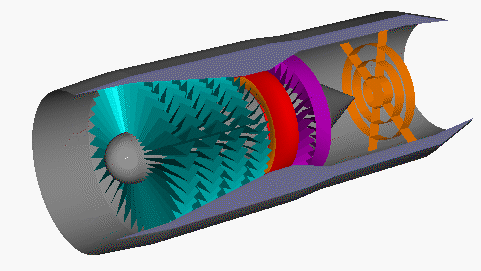
|
This page is intended for college, high school, or middle school students.
For younger students, a simpler explanation of the information on this page is
available on the
Kids Page.
|

|
Afterburning
Turbojet
|
Glenn
Research
Center
|








To move an
airplane
through the air,
thrust
is generated by some kind of
propulsion system.
Most modern fighter
aircraft employ an afterburner on either a low bypass turbofan
or a turbojet. On this page we will discuss some of the fundamentals
of an afterburning turbojet.
In order for fighter planes to fly faster than sound (supersonic),
they have to overcome a sharp rise in drag near the speed of sound. A
simple way to get the necessary thrust is to add an afterburner to a
core turbojet.
In a
basic turbojet
some of the energy of the exhaust from the burner is
used to turn the turbine. The afterburner is used to put back some
energy by injecting fuel directly into the hot exhaust. In the
diagram,
you'll notice that the nozzle of
the basic turbojet has been extended and there is now a ring of flame
holders, colored yellow, in the nozzle. When the afterburner is
turned on, additional fuel is injected through the hoops and into the
hot exhaust stream of the turbojet. The fuel burns and produces
additional thrust, but it doesn't burn as efficiently as it does in
the combustion section of the turbojet. You get more thrust, but you
burn
much more fuel.
When the afterburner is
turned off, the engine performs like a basic turbojet.
Afterburners are only used on supersonic aircraft like fighter planes
and the Concorde supersonic airliner. (The Concorde turns the afterburners off once
it
gets into cruise. Otherwise, it would run out of fuel before reaching
Europe.) Afterburners offer a mechanically simple way to augment
thrust and are used on both turbojets and
turbofans.
The
mathematics
describing the
thrust of an afterburning turbojet
is given on a separate slide.
Activities:


Guided Tours
-
 Jet Engines:
Jet Engines:

-
 Afterburning Turbojets:
Afterburning Turbojets:

Navigation ..

- Beginner's Guide Home Page
|
